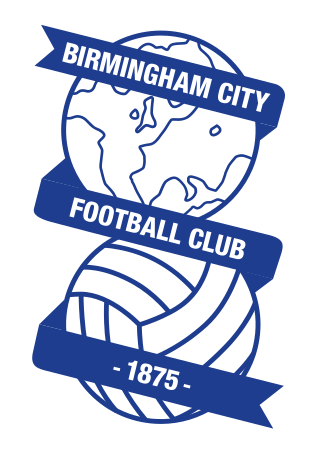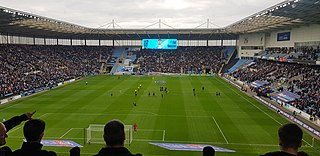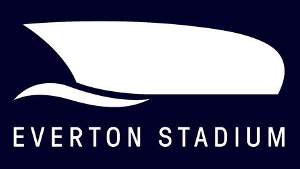
Birmingham City Football Club is a professional football club based in Birmingham, England. Formed in 1875 as Small Heath Alliance, it was renamed Small Heath in 1888, Birmingham in 1905, and Birmingham City in 1943. Its first team plays in EFL League One, the third tier of English football, following relegation in 2024.

The MKM Stadium is a multi-purpose stadium in Kingston upon Hull, England. It has a current capacity of 25,586. The stadium is home to both association football club Hull City A.F.C. of the EFL Championship and rugby league club Hull F.C. of the Super League.

Boundary Park is a football stadium in Oldham, Greater Manchester, England. Its name originates from the fact that it lies at the northwestern extremity of Oldham, with Royton and Chadderton lying immediately north and west respectively.
West Side Stadium was a proposed football and Olympic stadium to be built on a platform over the rail yards on the West Side of Manhattan in New York City.

St Andrew's, known for sponsorship reasons as St. Andrew's @ Knighthead Park, is an association football stadium in the Bordesley district of Birmingham, England. It has been the home ground of Birmingham City Football Club for more than a century. From 2018 to 2021, it was known as St Andrew's Trillion Trophy Stadium.

London 2012 was the successful bid to host the 2012 Summer Olympics, held in London with most events taking place in Stratford in the borough of Newham. The British Olympic Association had been working on the bid since 1997, and presented its report to government ministers in December 2000.

The Big City Plan is a major development plan for the city centre of Birmingham, England.

The New York City 2012 Olympic bid was one of the five short-listed bids for the 2012 Summer Olympics, ultimately won by London.

The Coventry Building Society Arena is a complex in Coventry, West Midlands, England. It includes a 32,609-seater stadium which is currently home to football team, Championship club Coventry City F.C. along with facilities which include a 6,000 square metres (65,000 sq ft) exhibition hall, a hotel and a casino. The site is also home to Arena Park Shopping Centre, containing one of UK's largest Tesco Extra hypermarkets. Built on the site of the Foleshill gasworks, it is named after its sponsor, Coventry Building Society who entered into a ten-year sponsorship deal in 2021. For the 2012 Summer Olympics, where stadium naming sponsorship was forbidden, the stadium was known as the City of Coventry Stadium.
Saltley is an inner-city area of Birmingham, England, east of the city centre. The area is part of the Washwood Heath ward, and was previously part of the Nechells ward. It is part of the Ladywood constituency in the city.
In the United Kingdom, a regional casino was the largest category of casino permitted under law – equivalent in size to the larger casinos in Las Vegas. The first regional casino was proposed in 2007 for Manchester, but the scheme was scrapped by the government in 2008.

Eastside is a district of Birmingham City Centre, England that is undergoing a major redevelopment project. The overall cost when completed is expected to be £6–8 billion over ten years which will result in the creation of 12,000 jobs. 8,000 jobs are expected to be created during the construction period. It is part of the larger Big City Plan project.
Birmingham Wheels Park was a dedicated Wheeled-sports park with a short-track oval motor racing circuit, MSA approved kart circuit, drifting arenas, off-road rally stage and a purpose-built outdoor speed-skating arena. The site is in the Bordesley Green area of Birmingham, England. Formerly run by a Charitable Company Limited by Guarantee, and controlled by Birmingham City Council, it is now closed and planned for redevelopment.

The Cardiff City Stadium is a stadium in the Leckwith area of Cardiff, Wales. It is the home of Cardiff City and the Wales national team.

Cardiff International Sports Village is located in Cardiff Bay in the city of Cardiff, Wales. It is one of the largest regeneration projects currently in the UK and is a public-private funded project.

The new Aberdeen stadium is a football stadium under early stages of construction in Kingswells, Aberdeen, Scotland. The new stadium, called Kingsford Stadium, would be the home of Scottish Premiership club Aberdeen FC to replace the existing Pittodrie Stadium. The development, 10.4 kilometres (6.5 mi) to the west of Aberdeen city centre, received planning approval from Aberdeen City Council in January 2018. Construction began in July 2018, with the first phase, a training facility named Cormack Park, opened in October 2019. The stadium had been scheduled for completion by 2023, but in the midst of disruption caused by the COVID-19 pandemic in Scotland, the club confirmed that the project had been put on hiatus, and in 2021 alternative designs at the city's beachfront close to Pittodrie were released.

The Birmingham bid for the 1992 Summer Olympics and Paralympics was an unsuccessful campaign, first recognised by the International Olympic Committee (IOC) on 28 February 1986. Ultimately it lost, having only gained eight votes with Barcelona going on to host the 1992 Summer Olympics. Its failure was due to a number of factors, including a perceived lack of support by the British Government for the bid as well as the international relations that the UK had at the time with South Africa and the United States.
Businessman Clifford Coombs took over as Birmingham chairman in 1965, and appointed Stan Cullis as manager. Cullis's attractive football took them to cup semi-finals, but league football needed a different approach. Successor Freddie Goodwin produced a team playing skilful, aggressive football that won promotion to the First Division as well as reaching an FA Cup semi-final. Two years later, the club raised money by selling Bob Latchford to Everton for a British record fee of £350,000, but without his goals the team struggled. In 1979, with relegation a certainty, the club sold Trevor Francis to Nottingham Forest, making him the first British player transferred for a fee of £1 million; Francis had scored 133 goals in 329 appearances over his nine years at Birmingham. Jim Smith took Birmingham back to the top tier, but a poor start to the 1981–82 season saw him replaced by Ron Saunders of league champions Aston Villa. The team still lacked goals, and were relegated in 1984. The last home game of the 1984–85 promotion season was marred by rioting and the death of a boy when a wall collapsed; the events formed part of the remit of the Popplewell inquiry into safety at sports grounds. Saunders quit after FA Cup defeat to non-League team Altrincham, staff were laid off, the training ground was sold, and by 1989 Birmingham were in the Third Division for the first time in their history.

Everton Stadium is a football stadium at Bramley-Moore Dock in Vauxhall, Liverpool, England, that will become the home ground for Everton ahead of the 2025–26 season, replacing Goodison Park.

The venues for the 2022 Commonwealth Games were based in Birmingham, Cannock Chase, Coventry, Royal Leamington Spa, Sandwell, Solihull, Warwick, Wolverhampton, and London.















